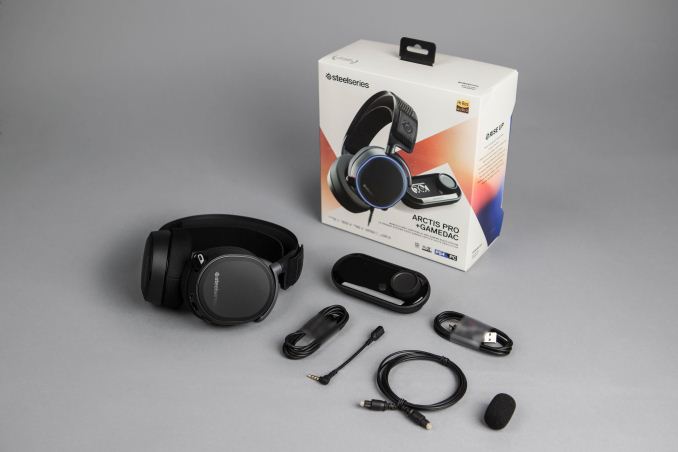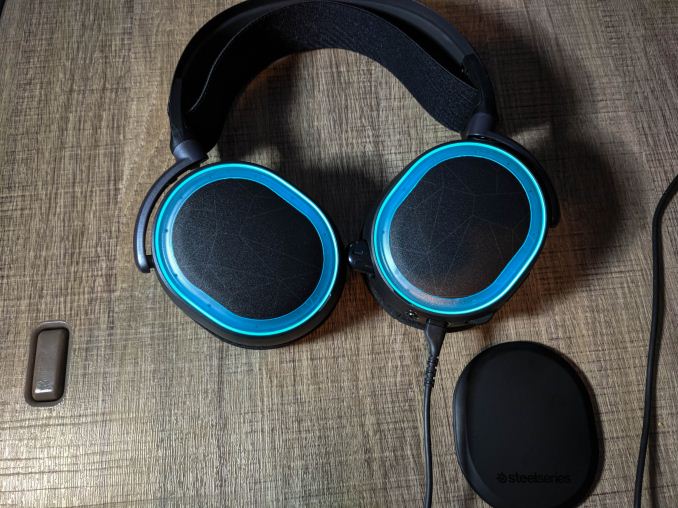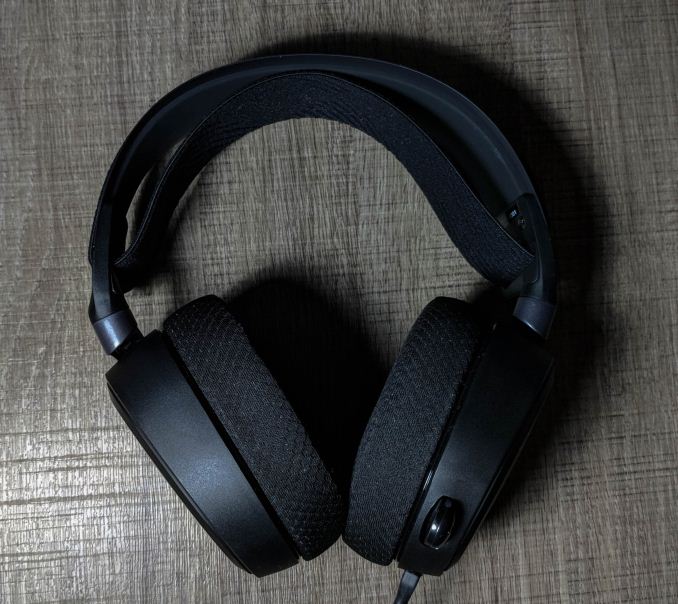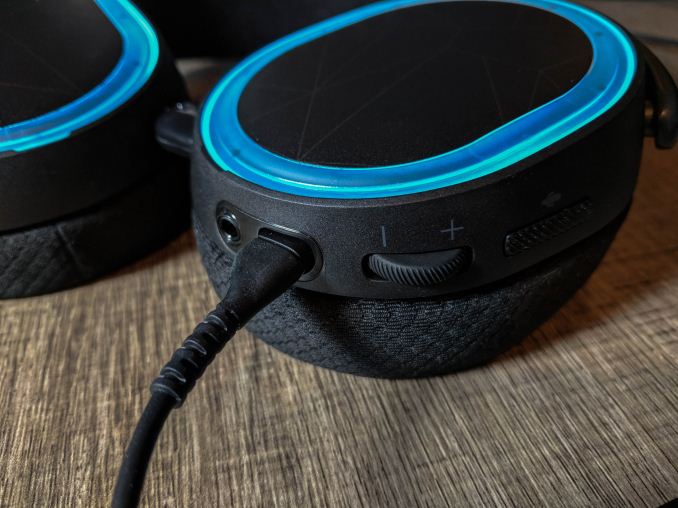The SteelSeries Arctis Pro Gaming Headset Lineup: GameDAC Or Wireless
by Brett Howse on March 13, 2018 9:00 AM EST- Posted in
- Headset
- Audio
- SteelSeries
- Accessories
- Arctis Pro
Arctis Pro Headset
If you’ve seen anything in the Arctis lineup of headsets from SteelSeries, you’ll notice right away that the Arctis Pro doesn’t go in a whole new direction in terms of styling compared to the other models in the Arctis line, and that’s not a bad thing. For those that like an understated look, Arctis definitely fits the bill. The headset is mostly black, with some gray accents on the hangers and strap, but the styling is muted, which looks great.
You can’t get an accessory anymore without some sort of RGB lighting, and the Arctis Pro features LED lighting around the outer edges of the speaker plates. The lighting, and effects, can be adjusted right in the GameDAC itself, or through the SteelSeries Engine Software, but it’s points to SteelSeries for not requiring the software to configure anything on the headset.
For those that do want a bit more edge to the styling, the speaker covers are just held on with magnets, and can easily be removed, which shows off more of the LED lighting, as well as a spiderweb design underneath. If you’d like to mix it up, SteelSeries also sells additional accessories for the headsets to customize the look a bit more.
The top strap has been slightly redesigned from the previous Arctis lineup based on customer feedback, and it features a “Ski Goggle Headband” with an adjustable strap, which lets you easily set the height the headset sits when being worn. The band provides even pressure, and overall, it’s very comfortable. The strap itself was perhaps a bit too tight when right out of the box, but a couple of weeks in and the pressure is much better.
The ear cups features “AirWeave” ear cushions, which, as the name implies, offers breathability when wearing the headset. There’s no problem with heat even after wearing them for several hours at a time. SteelSeries does offer a velour, as well as a leather ear cup, if you’d prefer that, but the AirWeave versions that come in the box are excellent.
All of the controls are on the left ear, and there’s not many since this is a wired headset. There’s a mute toggle switch, a volume knob, and the connectors. To connect to the GameDAC, the headset uses a proprietary cable which is close in size to a mini USB connector. This is in-line with the rest of the Arctis lineup, which also uses the same cable on the wired models. The cable itself is fine, but an improvement SteelSeries could have made would be to use a USB-C cable, which would be standard and easier to obtain if the original is damaged. The company does sell replacement cables on their website though, so if you do need a cable, it’s possible to get one.
The left ear cup also features a 3.5 mm input, so you could connect directly from any device, and in addition, SteelSeries ships an adapter cable from their own cable to 3.5 mm, making it very easy to hook up to a phone or other device which features a 3.5 mm jack. Here, again, USB-C would have been nice since you could also hook up to devices which have dropped the headphone jack.
Finally, there’s the bidirectional ClearCast microphone, which pulls out of the left ear cup on a flexible pole, and winds back up when not necessary. There’s a red LED on the microphone which turns on when the microphone is muted, so there’s never any doubt as to whether the microphone is enabled or not.
The build quality if the headset is very good. There’s no creaks or groans when putting the headset on, or taking it off, and features like the aluminum speaker hangers not only provide plenty of stiffness, but they keep the device weight down.
Overall, the experience with the headset has been very good, although there are a couple of small issues with the experience. First, the location of the volume and mute buttons on the back of the headset are right where your hands would naturally go when taking off or putting on the headset, so from time to time you’ll bump the buttons, which may turn on the red LED on the microphone, or raise or lower the volume.
The volume is the second point which could use some work. Unlike the volume control on the wireless model (which we’ll discuss soon) the GameDAC and headset have separate volume controls. What that means is that you can turn up the GameDAC to maximum, but you still won’t hear anything, and that’s because the volume on the headset is too low. It would be a better user experience if there was just a single volume control, especially when you bump the volume knob when removing the headset, and it can take a couple of seconds to realize why everything is so quiet. If the volume on both the GameDAC and the headset were tied together, that problem would be eliminated.
Finally, the Arctis Pro is a closed back design, which is great for isolation, but it would be nice to see an open back model as well, for those that do need to keep some connection to the real world, even if we don’t want to.














32 Comments
View All Comments
jimjamjamie - Tuesday, March 13, 2018 - link
So is this an advert or..?Stuka87 - Tuesday, March 13, 2018 - link
Pretty much every product a site like AnandTech reviews is given to them by the company that makes the product, but it doesn't read like an advertisement. It reads like a review that describes the product.Dr. Swag - Tuesday, March 13, 2018 - link
This doesn't feel like a review, but an announcement article, hands on, or advert.jordanclock - Tuesday, March 13, 2018 - link
I mean, it goes over the features, critiques them and then presents an opinion on the product. Sounds like a review to me.jordanclock - Tuesday, March 13, 2018 - link
But I will admit that this review doesn't seem very comprehensive. It's a lot of subjective assessment and the only objective measurement comes from the vendor.Samus - Tuesday, March 13, 2018 - link
I fail to see a real improvement over the Siberia 800. In fact, some aspects feel like a downgrade, particularly the lack of user replaceable\swappable batteries.One of the main selling points of the Steelseries H (which I own, predated the Siberia but is the same thing) was that it included two batteries and the base could charge one while the other was in use.
Samus - Tuesday, March 13, 2018 - link
Ahh, after actually reading the review and not just the first page, I see the Arctis Wireless does include two batteries and resembles the Siberia 800. I don't really see a difference other than the subjectively different driver tuning...Brett Howse - Tuesday, March 13, 2018 - link
Always read past the first page!These are a replacement for the Siberia 800 and offer better drivers. Siberia was 20-20Khz these are 10-40Khz. Plus the updated band from the Arctis lineup.
we - Thursday, March 15, 2018 - link
One thing irritated me somewhat while reading was that you seem to be giving the impression that headset frequency response is the primary indicator of headset sound quality, which is somewhat misleading. You can have two headphones, both with an excellent and just about identical frequency response, that sound very different, and one may even sound downright awful. A headphone with a mediocre frequency response may even sound better than one with an "ideal" on-paper frequency response. There are various reasons for this. One is that companies don't necessarily measure frequency response in the same way. Another is diaphragm linearity and break up. A cheap diaphragm may have excellent frequency response measured with a simple sine-wave sweep. But if it has to concurrently deal with strong bass tones and high frequency harmonics, the bass tones may push the the diaphragm outside of its most linear and most stable operating range, and as a result the HF tones may audibly suffer. You can't detect this kind of behaviour with typical frequency response measurments. Things like intermodulation distortion, driver linearity and break-up, damping and resonance characteristics of the transducer, its components and its housing can seriously influence subjective sound quality. Of course everything else being equal, the headphone with the better frequency response will outperform the one with a poorer frequency response. (I am not saying there is anything wrong with the headset tested. It may well be excellent, and apparently much thought has been invested in attaining high quality sound. In all probability, the designers know very well that a decent frequency response should be a given at this price point, and is only one of many aspects of design that have to be carefully considered to create a good headset)Brett Howse - Saturday, March 17, 2018 - link
It's not just frequency response, but that's a bit factor on these if you look at the graph. These don't have the boominess you'd see in some headsets where the bass response peaks at 60-100Hz and falls off drastically from there.